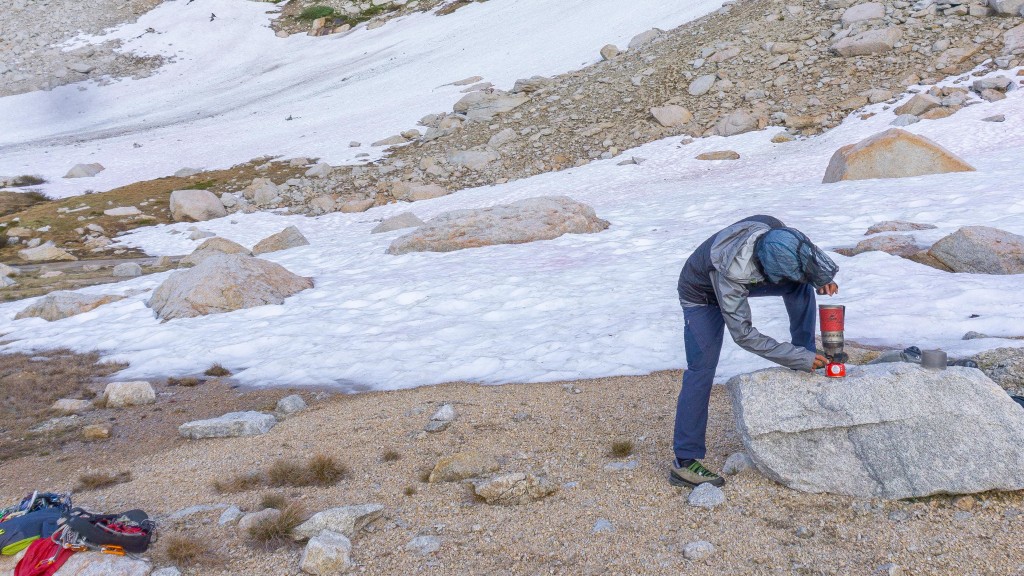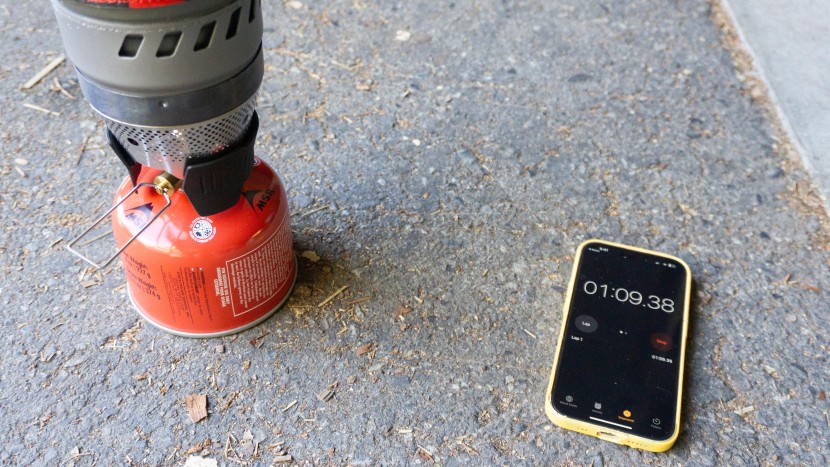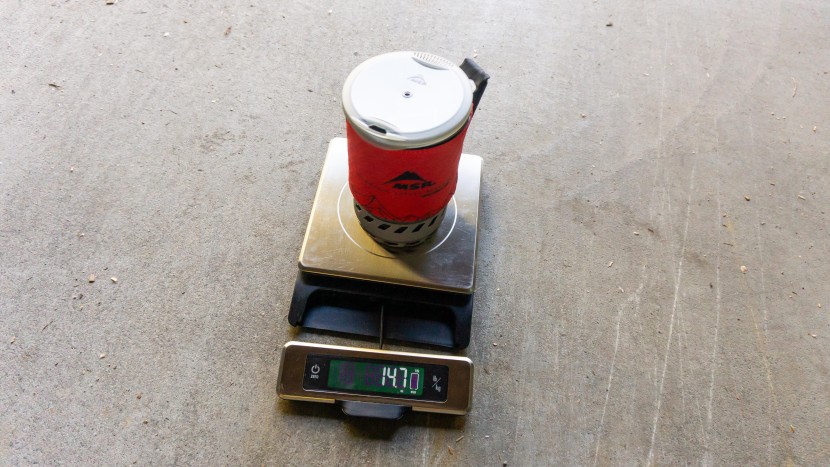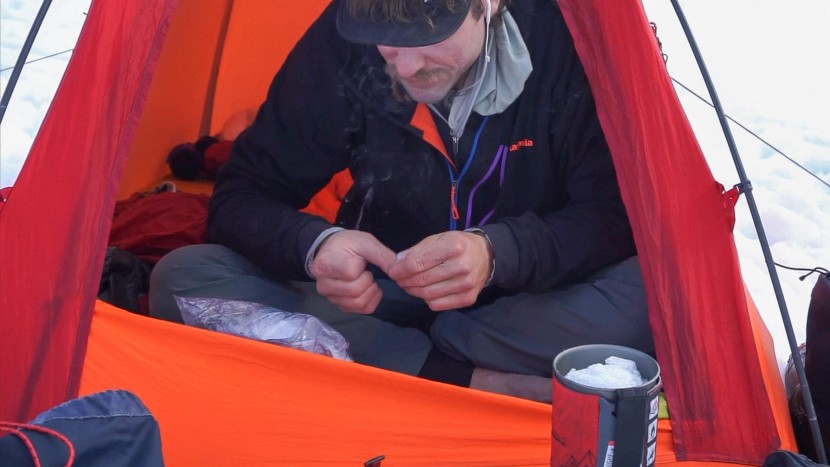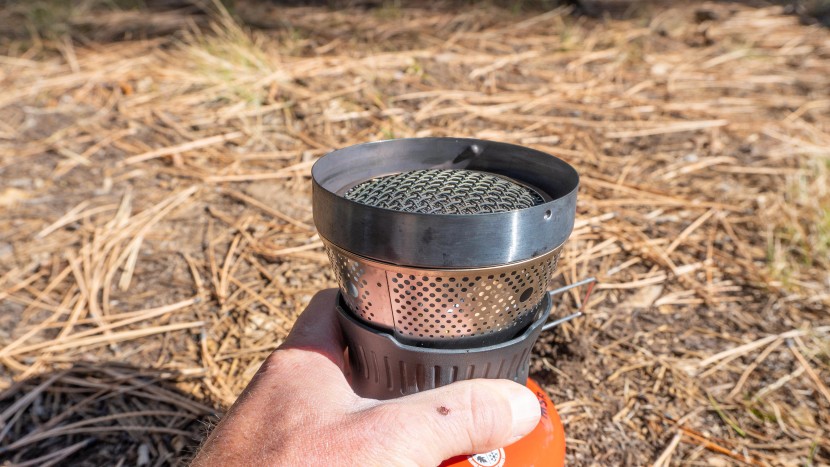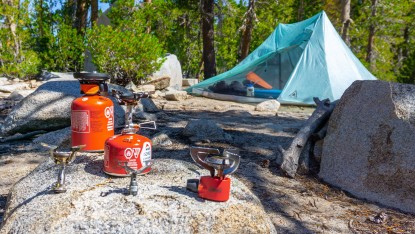
Our Verdict
Our Analysis and Test Results
After a lengthy field testing process spanning multiple seasons, we're happy to report that the MSR Windburner is a top-tier backpacking stove that's both versatile and durable. While there are lighter stoves for summertime camping, and more robust stoves for winter overnights, the Windburner can handle all four seasons, making for a great “one stop shop” option.
Fuel Efficiency
The radiant burner on the Windburner is fully enclosed, thanks to the integrated heat exchanger on the bottom of the pot, helping keep the heat flowing directly to the pot. When things got cold and blustery, the Windburner held its own.
In our controlled fuel efficiency testing, the Windburner used approximately .21 ounces of fuel per boil — quite decent. This stove stood out for its efficiency in less pleasant camping conditions. While other stoves started to struggle in the cold or high elevation environments, the Windburner's fuel usage was less affected by wind and cold.
Weight
As a year-round model meant to battle the elements, it was no surprise when we saw the higher numbers on the scale. This isn't where we'd steer the gram-counting thru-hiker, but the Windburner is relatively light when considering its wintry performance.
At a hefty 14.7 ounces, the Windburner isn't going to take home any featherweight prizes, but for a 4-season option, this wasn't too heavy for the durability and reliability trade off. The stove and an 8-ounce isobutane canister fit easily inside the pot, which is just slightly larger than a Nalgene, making this a fairly packable model.
Simmering Ability
This was a boil-only stove for most of our testing team, though we were able to cook from-scratch meals if we kept the pot or skillet high enough above the flame. However, MSR didn't design the Windburner to be a gourmet dinner-making machine, and we recommend looking elsewhere if you need simmering abilities.
We were big fans of the Windburner for several reasons, but simmering prowess wasn't one of them. We had a tough time cooking noodles, with the boiling water rising over the top of the pot quickly, even with the stove on low. Similarly, our skillet cooking experience was challenging, causing our bacon and veggies to go from raw to torched very quickly. Fortunately, we did get the hang of holding the cookware higher above the stove, and in some locations, we were even able to use rocks as a makeshift skillet platform. Most of the integrated canister stoves had a similar simmer performance to the Windburner, though we found this model to run a bit hotter on its lowest setting.
Wind Resistance
The aptly named Windburner really shined in this metric, with a fully enclosed system protecting the radiant burner. From bivouacs on ridgelines to low-elevation dust storms, we were able to keep the flame going most of the time. Simply put, this should be on your finals list if you need a stove that can battle gusty days and nights.
While some of the competition needed twice as much fuel to boil water in the wind, we found a very minor reduction in fuel efficiency with the Windburner. There was a slight uptick in boil time, but the Windburner performed admirably, making wind resistance one of its best features and a primary reason why we determined it to be a 4-season backpacking stove.
Ease Of Use
You likely won't need an instruction manual to use the Windburner, and with a black plastic collar at the base of the stove, it's much easier to keep from getting burned if you need to adjust the unit while it's hot. While other 4-season models have a substantial amount of exposed metal, this option has an insulated cozy wrapped around the outside of the pot, with an integrated cloth handle that's much less likely to burn you.
When in close proximity to the stove, the last thing you want is for a pot of hot water to tip off the burner, but the Windburner has a great locking system, which securely attaches the burner to the pot. This model also includes a decent cup, which slides easily over the bottom of the pot while in transit. We strongly urge caution when using any product's lid and pour spout, as we've seen most lids on this style of stove pop off, and the Windburner's lid is no different. Lastly, the valve was easy to adjust, even with gloves on, which is a crucial consideration when shopping for a 4-season stove.
Should You Buy the MSR Windburner?
This is a true do-anything model, but it comes with some important asterisks. If you need a one-size-fits-all stove that can boil water and saute on a skillet, the Windburner isn't the right fit. Additionally, if you need a stove that is the absolute lightest, you're better off looking elsewhere. Outside of these considerations, the MSR Windburner is a powerhouse of an integrated canister stove, and our testing team grew to truly trust its performance, even in cold and remote places where a functional stove was vital to our safety. Even if intending to stick to summertime adventures, this is a worthwhile model if you prioritize reliability over weight.
What Other Backpacking Stoves Should You Consider?
If you need the most robust option for melting snow to make water, the MSR Reactor is the most heavy-duty isobutane stove we've ever seen. While it's not as user-friendly as the Windburner, its rocket-esque burner got our water boiling fast and offers an even hotter radiant burner. If weight is the biggest concern, consider the Jetboil Stash, which is a fantastic model for fuel efficiency in a lightweight package. The Stash doesn't lock to its burner, so consider its sibling, the Jetboil Flash, if needing that locking function in your integrated canister stove.



